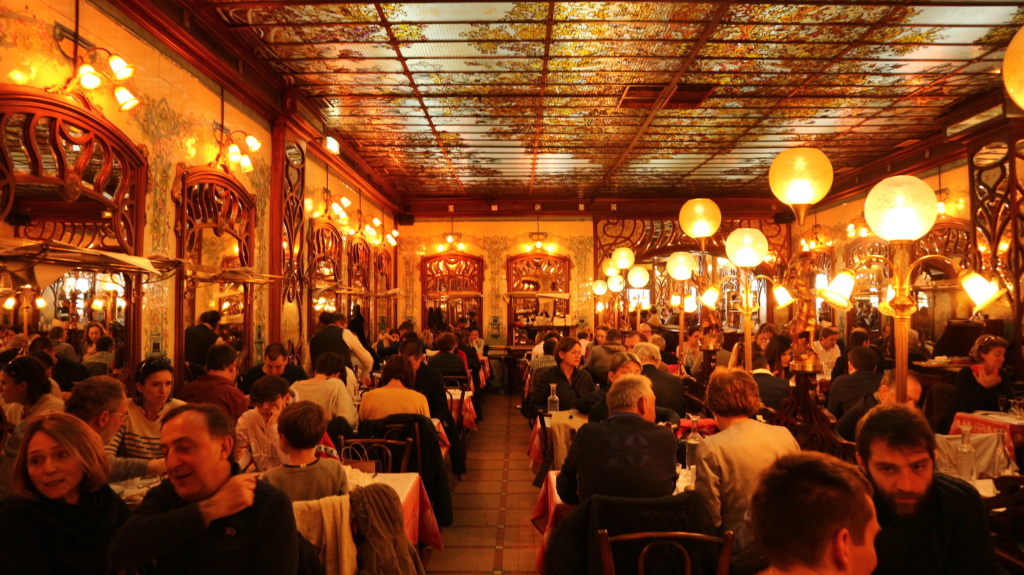
The glamorous Opera Garnier is one of the most popular sites in Paris. Visited by tourists and locals alike, le Palais Garnier enchants with its extravagant design, sumptuous interiors and urban legends. Designed by the young architect Charles Garnier the enormous project was begun in 1861 and was inaugurated in 1875. Although most operatic performances are now put on at the new Opera Bastille, the Palais Garnier is still used for ballet, concerts and some operas and is very much a part of the Parisian performing arts scene. Discover more about the history and intriguing features of the Opera Garnier below!

The Opéra de Paris is over 350 years old.
The institution that is, not the building itself. The Opéra de Paris was founded under the rule of Louis XIV in 1669. The Italians already had an academy of opera and it was time for France to have one, too. Therefore, the Opéra de Paris celebrated its 350th birthday in 2019.
Several other Opera Houses Predated the Palais Garnier.
With 350 years of history it isn’t surprising that a number of different buildings were dedicated to this performing art over the centuries. The first was opened in 1671 on the Left Bank at 42 rue Mazarine in the 6th arrondissement. The opera house just before Garnier’s design was built in 1821 and located a short distance away on rue Le Peletier. It was still used while the “new” opera house was being built, however, it was ravaged by fire on October 29th, 1873 and subsequently torn down.

A Bomb Attack on Napoléon III Sparked the New Opera House.
On January 14th, 1858, the Emperor and Empress were on their way to opera house on rue Le Peletier when Italian anarchist Felice Orsini tried to bomb their carriage. Although the Imperial couple were unscathed thanks to their iron-lined carriage, the blast injured 156 people, including eight fatally. It was so strong that it blew the glass of the windows of the area’s buildings and to left three large craters in the street. The building of a new opera house was declared in public’s interest and for the safety of the head of state.
The Unfinished Building was as a Military Warehouse During the Franco-Prussia War.
Napoléon III never got to attend a performance at his new opera house because he was ousted during the Franco-Prussia war of 1870. The disastrous war had other effects on the opera house as well. After Napoléon was captured, the city was endured a four-month siege by the Prussians. During this time the unfinished building was used as a food and straw depot and hospital for the military. In 1871 the building was then used by Communard revolutionaries due to its proximity to Place Vendome, where fierce fighting was taking place during the Paris Commune uprising.

The Opera Garnier was the Most Expensive Building Built During its Time.
Heavily indebted by the costly Franco-Prussian war and the consequent repatriations to Germany, the new Third Republic government were lacking the funds required to complete the building. It resorted to borrowing 4.9 million gold francs from François Blanc, the wealthy financier and real estate developer behind the Monte Carlo Casino. The total costs soared to over a 7 million francs, the equivalent to over 300 million euros today.
The Building was an Artistic Tour de Force.
The cost sounds exorbitant, however, the project involved many of the greatest artists and artisans of the era, including 73 sculptors, 14 painters, many mosaic artists and countless other craftsmen. Garnier carefully selected the finest materials, the grand staircase alone has 30 different marbles from 8 different countries. Other than the grand staircase, the two other most famous works of art on the building are The Dance by Carpeaux and the auditorium ceiling by Chagall, both which caused a certain amount of controversy.
The facade was unveiled before the building was completely and Carpeaux’s grouping of gleeful dancers was considered too racy, so much so that on the night of August 26th to 27th, 1869 a bottle of ink was thrown on the statue. The original is now on display at the musée d’Orsay. Today visitors to the Opera House gaze up in awe at Marc Chagall’s 2,600-square-foot ceiling representing scenes from operas by 14 composers, however, many were not so enthusiastic when a foreign modernist artist had been selected for the project and his work received mixed reviews when it was inaugurated in 1964.

There Really Is an Underground “Lake” — Well, Yes & No.
Part of the reason the building cost so much was that when construction began in 1861 it was discovered that the land was very wet. After months of trying to pump out the excess water in 1862, Garnier decided to add in a large cement reservoir to solve the water issue. It still exists today, although not quite as atmospheric as described by Gaston Leroux in his novel The Phantom of the Opera, published in 1911.
The Legendary Episode of the Falling Chandelier Really Happened.
Just like the “lake,” the opera’s chandelier also had a tragic fall like in Leroux’s fictive tale. A luminary masterpiece designed by Garnier himself, the seven-ton bronze and crystal chandelier collapsed on a full house of theater-goers during a performance of Faust on May 20, 1896. The incident killed one spectator.

It was the First Opera House in the World to Have Electricity.
Installed in 1883, the Palais Garnier had a small power plant in the basement to generate electricity to the building and to provide lighting using bulbs by Thomas Edison. It was not only the first opera house to have electricity, it was one of the first buildings in all of Paris using this new technology. In addition, this caused a shift in the theater experience. It became a new concept to have the auditorium in darkness during a performance, which was previously lit by gaz lamps throughout the show, allowing attendees to people-watch throughout.
It has the largest stage in Europe, which is also Slanted.
The vast stage of the Palais Garnier is the largest in Europe, measuring 52 meters wide by 62 meters high–large enough to fit the Arc de Triomphe! After having traveled Europe to visit other opera houses, Garnier adecided to add a slight incline to the stage, a concept which already existed in Italy. The 5% incline means that the stage is one meter higher at the back than the front, allowing visitors to have a better view.
Bonus!
In the 1980s Paris received a new opera house, the Opéra Bastille designed by Uruguayan architect Carlos Ott. It was inaugurated on July 13th 1989, on “Bastille Day,” to commemorate the bicentenaire French Revolution…. and cost a 100 million euros more than Garnier’s flamboyant work.
Stay tune Sunday May 31st at 2:30 pm EST / 8:30 pm Paris time when I’ll be sharing our latest participatory short story… taking place at the Opera Garnier!
Read our short story set in the Opera Garnier at this link!
Main photo by: Mariano Mantel/Flickr




